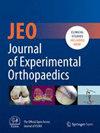New algorithm for management of multiligament knee injuries: A tertiary level trauma center experience
Abstract
Purpose
Multiligament knee injuries (MLKIs) are severe orthopedic traumas frequently associated with concomitant structural damage, often leading to significant long-term morbidity. This study aimed to evaluate the rate of return to work (RTW) following the management of MLKIs using a standardized treatment algorithm.
Methods
This prospective interventional study included patients with MLKIs who presented to a tertiary trauma center between 2019 and 2022. A total of 32 patients (30 males and 2 females) were enrolled and classified according to the Schenck classification system. The median age at the time of injury was 31 years (range: 17–60 years). The mechanism of injury was high-energy trauma in 21 patients, sports-related trauma in eight patients, and low-energy trauma in three patients. Clinical outcomes were assessed at final follow-up using the Lysholm score, International Knee Documentation Committee (IKDC) subjective knee evaluation form, University of California Los Angeles (UCLA) activity score, and return to work status.
Results
At a mean 2-year postoperative follow-up, the average range of motion across all patients was 134.2° ± 16.6°. The mean postoperative Lysholm, IKDC, and UCLA scores were 86.4 ± 12.6, 65.9 ± 9.7, and 6.9 ± 2.2, respectively. Notably, 90.6% of the patients achieved a successful return to their previous work. The proportion of patients returning to work was significantly higher in the Knee Dislocation Injury (KDI) group compared to the other three Schenck classification groups, which showed no significant difference among themselves. Radiographic evidence of osteoarthritis (OA) was observed in four cases (12.5%).
Conclusion
This study demonstrates that satisfactory to excellent short-term clinical outcomes, including a high rate of return to work, can be achieved following ligament reconstruction for multiligament knee injuries when utilizing a standardized treatment algorithm. However, the potential for long-term complications, such as the development of knee osteoarthritis, warrants careful consideration and continued monitoring.
Level of Evidence
Level IV.





 求助内容:
求助内容: 应助结果提醒方式:
应助结果提醒方式:


